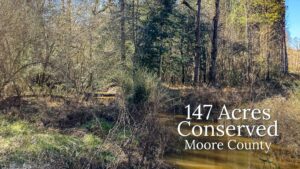
by Lucas Crim, LandTrust intern summer 2015
August 13, 2015

When I first started my summer internship with The LandTrust for Central North Carolina (LTCNC), I didn’t quite know what to expect. I had heard much about the organization’s mission and accomplishments from Ms. Crystal Cockman, the newly appointed Executive Director and former Associate Director, during our conversations throughout the interview process. I was also lucky enough to have my older brother as a resource, as he held the exact same position in the summer of 2014. Still, as a transplant from a rural agricultural town in Idaho, I was unfamiliar with the wilderness throughout my adopted state of North Carolina. Growing up, I spent many days with my grandparents in massive old growth forests deep in the mountains of eastern Oregon, which are just a little bit larger than the “mountains” I’ve encountered in the Piedmont region. However, over the last three months, I’ve gained a vast appreciation for these lands and the people who work so hard to conserve them for my generation and those to come.
When I showed up for my first day of work in Salisbury, I expected to encounter a large office with numerous employees and interns working individually. Instead, I found a small, friendly office space with just a handful of employees and interns, working extremely hard and collaborating on conservation projects near and dear to their hearts. Most had grown up in the area, and they have committed their lives to preserving the undeveloped tracts of land in the Piedmont region. After working with each of these individuals over eleven weeks, it has become very clear to me that the work The LandTrust does is absolutely essential to the region’s future. In Idaho, we take for granted the massive tracts of land protected by the government. For example, the 2.367 million acre Frank Church-River of No Return Wilderness Area in Idaho was protected by Congress in 1980. When The LandTrust recently topped the 25,000-acre mark for conserved lands in the state, I had to stop and think of the difference between the two feats. Idaho is a very large state with a very small population, and much of its protected lands are due to government acts and initiatives. In North Carolina, land conservation is largely the work of small non-profit organizations, like the LTCNC, who work tirelessly with volunteers, cities, and government agencies. Because of this difference, I have gained a massive appreciation, and a very sincere sense of pride, for the work that I have been able to complete through the LTCNC.
While doing this work, I have had the pleasure to meet many hard-working individuals, ranging from volunteer trailblazers to

part-time boundary markers to Duke University Master’s candidates and graduates, who come from Iowa, upstate New York, North Carolina, and, seemingly, everywhere in between. These individuals form a close-knit, but welcoming, community, and I feel very lucky to have played a small role in accomplishing their goals. I will always be an Idaho boy at heart, but I have gained a very sincere appreciation for the people and lands of North Carolina, especially in the Piedmont region. I could not have enjoyed my time at The LandTrust for Central North Carolina anymore, and I will never forget my experiences there, from the picturesque Uwharries to the historical Cooleemee Plantation, and all of the people and places in between.